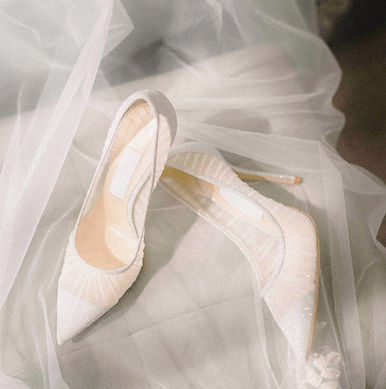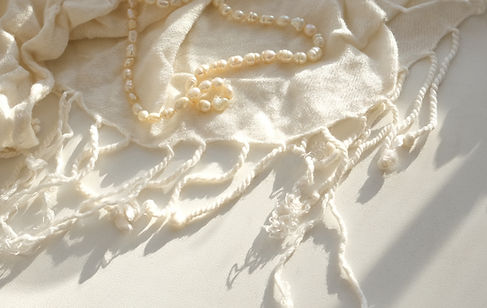
Filling the Shoes
HOW COLD FEET LED TO UNANSWERABLE LOVE
Published by P.S. I Love You | A Medium Curated Selection
There is a box on the high closet shelf marked Stacy’s wedding shoes.
Inside the shoebox is a pair of pointy-toed, slender-heeled pumps covered in tattered lace and miniature pearls.
My feet do not fit in the shoes anymore. Though I can jam a foot in, almost, like a Cinderella stepsister trying to fit the glass slipper for the prince.
They say an adult foot grows with life, with pregnancy, running and age.
The day I stood on the altar in the shoes with their patterns of pearls I was 26. A scared, skinny girl in a blush-colored dress with shoulders peeking out and long hair piled high in a questionable style.
I do not fit in that girl anymore either.
Too much life.

That Saturday afternoon, 29 years ago, I stood in the pearl shoes, the rain pummeling down outside the stain-glassed windows of the church. Saying vows, looking into the eyes of a man with too much enthusiasm and too little doubt, after I had left him waiting an hour for me to get to the aisle.
Down in the church basement, refusing to put on my shoes, I’d had cold feet.
If you resort to the dictionary, the term cold feet means: “a sudden loss of nerve when embarked on an adventure.” Notably not “embarking.” Your
“unusual and exciting, typically hazardous experience” must be underway.
No one seems to agree on the origin of the meaning of cold feet. It might have come from German literature referring to a backing away from a poker game after a change of fortune. It might have come from ancient Athens, wherein ingesting Hemlock as a death penalty made the extremities go cold. Maybe the term came from wading into water, which grows colder as it deepens.
Pacing the musty carpet of the basement, I knew I was about to wade in deep. Marriage was a blank check. An all in I do, yet I did not know what I would be asked to do. Better and worse, sickness and health and joint checking accounts could come and keep coming. And I would have already said yes.
In the weeks leading up to the wedding, I wrote long lists of questions on yellow legal pads and posed them to the man who was to become my husband. Looking at the inscrutability of the future, I wanted him to tell me how our fortunes would turn and how we would fit inside the years together.
I should have married him right then when he sat on the couch patiently answering each question, even though he knew he could not give me the answers I wanted. Those answers were the ones that had to be lived into.
Halfway into the delayed wedding ceremony, the guests sat hushed and a guitarist sang a song. Bride and groom stood facing each other, me in my shoes, he in his smile, listening to the refrain: whenever two or more of you are gathered in his name, there is love. A tear slipped down his cheek. I reached across and wiped the tear with my thumb, gently, wordlessly.
There was my vow.
There was what the girl could not see.
The girl standing in the small shoes could not see the moving away, baking bread in the narrow kitchen of a new two-bedroom apartment, swimming with a manatee. She could not foresee the image of a daughter drifting on a sonogram screen all big head and belly, tiny fists. The feeling of soft baby breath on her chest, knowing what it is like to exist in more than one place.
She maybe could have imagined the buying of a first house with a small porch, but not the messy crafts by the pool, the coffee pot in the open kitchen with the sunlight falling through the important talks. Homework on the tall stools. She may have considered the growing careers as years piled behind them, but she could not have seen the traditions gathering around them.
She never could have predicted the sorrow. The slipping away of a child from inside her. How he would not feel the loss as much as she did, and they would drift apart a while in the silence of her grief. She could not see from the altar how one night she would ask him another question, just one: Would you adopt a baby girl with me? And he would say yes in one breath. Then before the baby girl in the photographs could come, they would be told she was sick, maybe really sick. And he would say yes, no matter what, again.
She could not know the pencil lines on the kitchen wall would inch up with the heights of two healthy girls growing. That he would wait for her at the finish line of her half-marathon and she would wait for him after his shoulder surgery and somehow both would be triumphant. How gray would sneak into the hair at his temples and he would cover it up until she told him she liked it. How sometimes she’d put the spatula in the wrong drawer just for fun. That they would yell about toilet paper and mortgage payments and bread. How in a recession and a pandemic they would see those things did not matter much.

When the minister finally pronounced a husband and wife, threatening men to not put us asunder, the guests in the pews of the church erupted into wild applause. They had waited. This wedding had not been a given. None are.
The woman, who has outgrown the shoes and the girl, I know this now. Asking for good and careful things leaves out the beauty. Beauty is the laughter and loss, the anger and distance, the hug between unloading the dishwasher and feeding the dogs. The waiting there at whatever are the ends.
A vow is not an answer. It is a gathering of love. A reaching across.
There is a box on the high closet shelf marked Stacy’s wedding shoes.